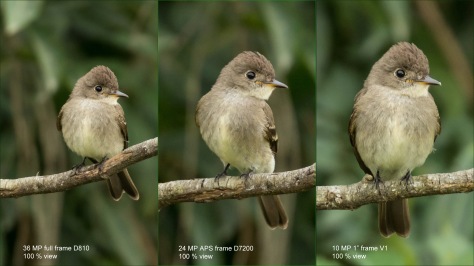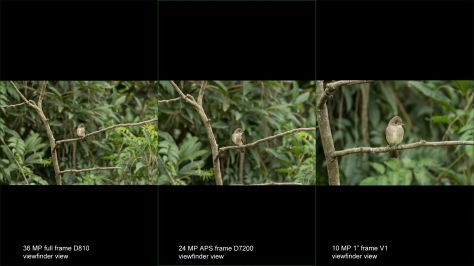A lot of what I’ve read about using cropped-frame vs. full-frame cameras for wildlife photography is written by people with access to really long lenses, a choice of cameras, and fairly big animals to photograph in the field. I know this is not true for most photographers and I want to write this for them.
Long lenses are heavy and expensive, require large tripods and gimbal heads and can be a pain to carry in the field. There are great zoom lenses like the new Sigma, Tamron and Nikon in the 200-500 mm range that are far lighter and affordable. Their only drawback is that they are not large aperture optics and are difficult to use in forests.
I know wildlife photographers using 600 mm and longer lenses on full-frame cameras that claim that cropping their photos when necessary is the way to go in bird photography. Now, herons might be fairly large birds but most songbirds are really small and look tiny in the viewfinder of full frame (FX) cameras. I much rather use a cropped frame (DX) camera and see a larger image to better compose and focus my photos. I even own an older Nikon 1 (CX) camera that has a 1” sensor which gives a lot of reach when with Nikon lenses using an adapter.
The question is: is it better to crop your images after you take them, or do the cropping by using a smaller area of the image circle of the lens (which is what DX and CX format cameras do)?
I don’t want to get too technical or opinionated about this. Here are some photos of an Elaenia that was kind enough to remain in the same perch some 24 ft (8 m) away while I changed cameras three times on my Nikon 80-400 lens set at 400 mm. A fairly common distance and lens setup when doing songbird photography.


You can draw your own conclusions about image quality, pixel size or convenience. For me, I much rather travel light, not disturb the wildlife by getting too close, and see a larger image of my subject in the viewfinder by using an APS (DX) sized sensor.
Would this be your choice too?

I think I detect some slight unsharpness in the bird’s eye on the cropped photo but agree seeing thru the viewer and weight of the setup is an overriding issue. Thanks for sharing.
LikeLiked by 1 person
You are right. The bird changed position afterwards and I couldn’t get a sharper photo to compare!
I decided to go ahead and post it as I was trying to emphasize the different viewfinder image sizes.
LikeLike